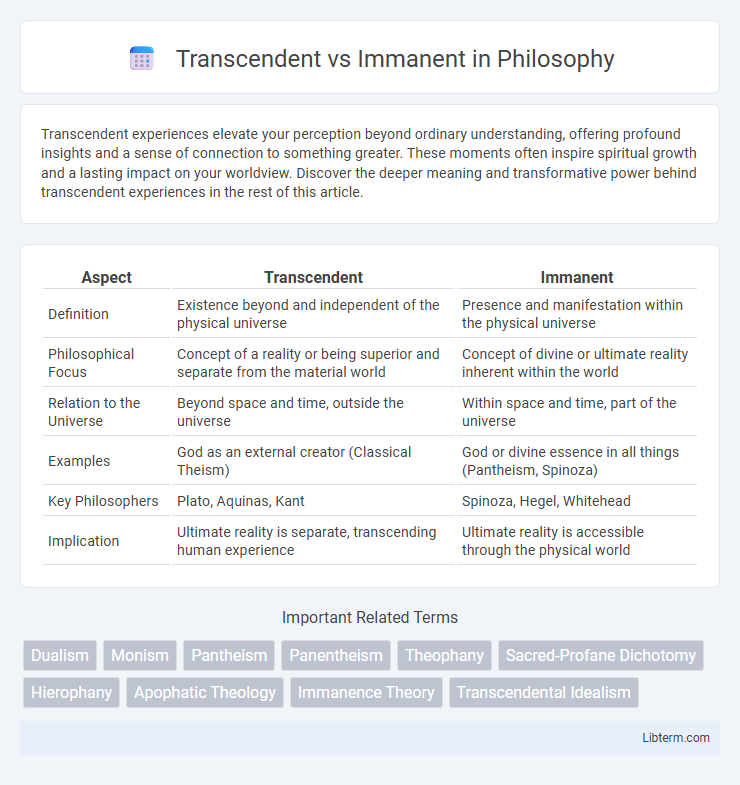Transcendent experiences elevate your perception beyond ordinary understanding, offering profound insights and a sense of connection to something greater. These moments often inspire spiritual growth and a lasting impact on your worldview. Discover the deeper meaning and transformative power behind transcendent experiences in the rest of this article.
Table of Comparison
| Aspect | Transcendent | Immanent |
|---|---|---|
| Definition | Existence beyond and independent of the physical universe | Presence and manifestation within the physical universe |
| Philosophical Focus | Concept of a reality or being superior and separate from the material world | Concept of divine or ultimate reality inherent within the world |
| Relation to the Universe | Beyond space and time, outside the universe | Within space and time, part of the universe |
| Examples | God as an external creator (Classical Theism) | God or divine essence in all things (Pantheism, Spinoza) |
| Key Philosophers | Plato, Aquinas, Kant | Spinoza, Hegel, Whitehead |
| Implication | Ultimate reality is separate, transcending human experience | Ultimate reality is accessible through the physical world |
Understanding Transcendence and Immanence
Understanding transcendence involves recognizing entities or realities that exist beyond and independent of the physical universe, often associated with divine or metaphysical realms. Immanence, by contrast, emphasizes the presence and operation of the divine or ultimate reality within the material world and everyday experience. These concepts are fundamental in philosophy and theology for interpreting the nature of existence, divinity, and the relationship between the finite and the infinite.
Historical Roots of Transcendent and Immanent Thought
Transcendent thought, rooted in ancient metaphysical traditions such as Platonism, emphasizes a reality beyond sensory experience, prioritizing eternal forms or divine entities existing outside the material world. Immanent thought, traced back to Stoicism and certain Eastern philosophies like Advaita Vedanta, refers to the divine or ultimate reality inherent within the natural world and human consciousness. These contrasting historical roots shape major theological and philosophical debates on the nature of existence, divinity, and the relationship between the finite and the infinite.
Transcendence in Major World Religions
Transcendence in major world religions emphasizes the divine's existence beyond the physical universe, surpassing human understanding and natural laws. In Christianity, God is often viewed as transcendent, dwelling above and outside creation yet engaging with it; Islam similarly portrays Allah as incomparable and beyond all worldly confines. Hinduism also recognizes transcendence through Brahman, the ultimate reality that exists beyond the material world, while maintaining immanence within it.
Immanence in Philosophical and Spiritual Traditions
Immanence in philosophical and spiritual traditions refers to the presence of the divine or ultimate reality within the material world and human experience, emphasizing an inherent unity between transcendent principles and embodied existence. Key figures such as Baruch Spinoza describe God or substance as immanent, permeating all aspects of reality rather than existing apart from it, while Eastern philosophies like Advaita Vedanta assert the self (Atman) is fundamentally one with Brahman, illustrating spiritual immanence. This concept challenges dualistic frameworks by asserting that sacredness and ultimate truth are accessible within the natural order and everyday life.
Key Differences Between Transcendent and Immanent Perspectives
Transcendent perspectives emphasize existence beyond and independent from the physical universe, often associated with divine or spiritual reality external to human experience. Immanent perspectives focus on presence within the world, highlighting divine or spiritual reality as inherent and pervasive in nature and human consciousness. Key differences include the locus of divinity--outside versus within the universe--and the manner of interaction, with transcendence implying separation and transcendence, while immanence suggests closeness and indwelling presence.
The Role of God: Beyond vs Within the Universe
God's transcendence signifies existence beyond and independent of the universe, emphasizing an eternal, all-powerful being who is not limited by physical reality. In contrast, divine immanence highlights God's presence within the universe, actively sustaining and permeating all aspects of existence. These concepts delineate the dual role of God as both the creator transcending creation and the indwelling spirit intimately involved in the cosmos.
Transcendence and Immanence in Modern Theology
Transcendence in modern theology emphasizes God's existence beyond and independent from the material universe, highlighting divine authority, mystery, and otherness. Immanence underscores God's presence within creation, stressing relationality, accessibility, and ongoing involvement in the world. Contemporary theological discourse often explores the dynamic tension between transcendence and immanence to reconcile divine majesty with intimate closeness.
Implications for Personal Spiritual Experience
Transcendent spirituality emphasizes connection with a divine reality beyond ordinary experience, often inspiring awe and a sense of ultimate meaning that transcends the self. Immanent spirituality highlights the sacred presence within the self and the natural world, fostering a deep sense of unity and interconnectedness in personal practice. These perspectives shape individual spiritual experiences by influencing whether one seeks external revelation or internal awakening as the pathway to enlightenment.
Contemporary Debates: Transcendent vs Immanent Approaches
Contemporary debates on transcendent versus immanent approaches center on the nature of divine presence, with transcendent perspectives emphasizing a divine reality beyond and independent from the physical world, while immanent views highlight God's presence within and throughout the natural order. These discussions influence theological interpretations and ethical frameworks, as transcendent approaches often stress otherworldly authority and ultimate truth, whereas immanent approaches foster integration with human experience and environmental interconnectedness. Scholarly discourse frequently engages with metaphysical implications and practical consequences of each stance, shaping modern spiritual and philosophical thought.
Integrating Transcendence and Immanence for Holistic Understanding
Integrating transcendence and immanence involves recognizing the coexistence of the divine beyond and within the material world, creating a comprehensive perspective that bridges spiritual and physical realities. This synthesis fosters a holistic understanding by emphasizing the interplay between the infinite, ineffable aspects of existence and the immediate, tangible presence in everyday life. Such integration enriches philosophical, theological, and metaphysical discourse, promoting unity and depth in exploring the nature of consciousness and reality.
Transcendent Infographic

 libterm.com
libterm.com